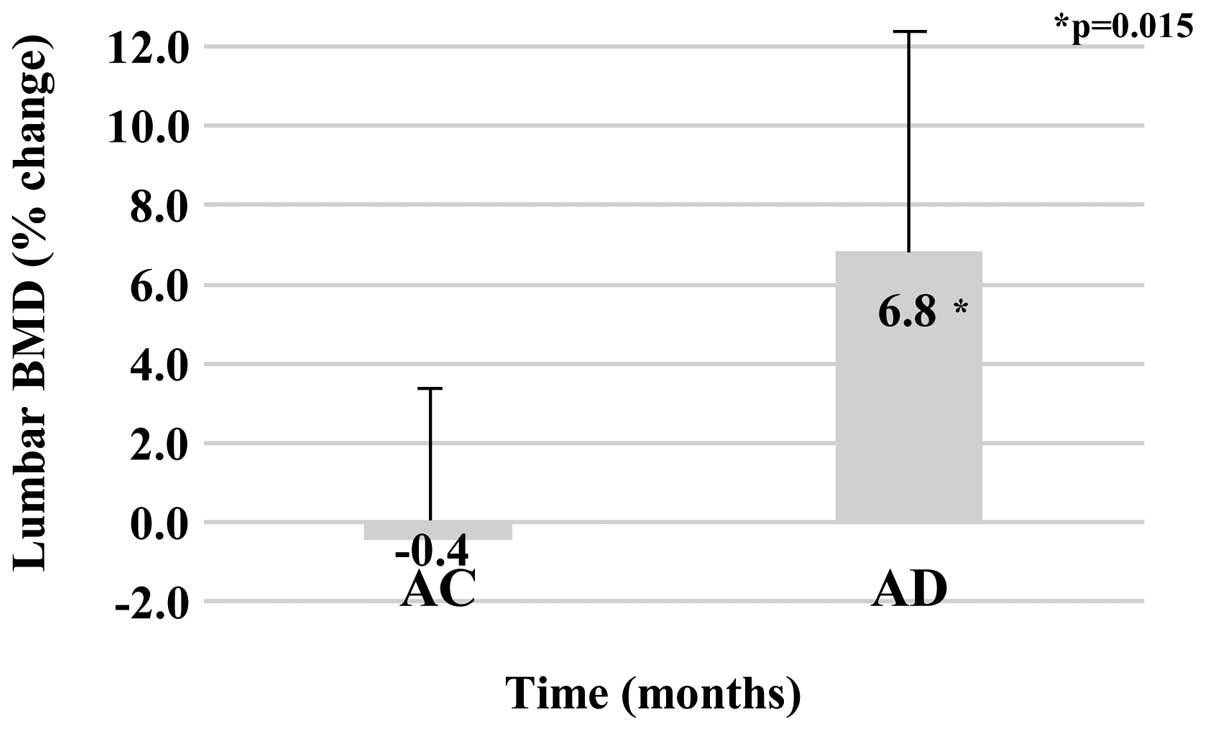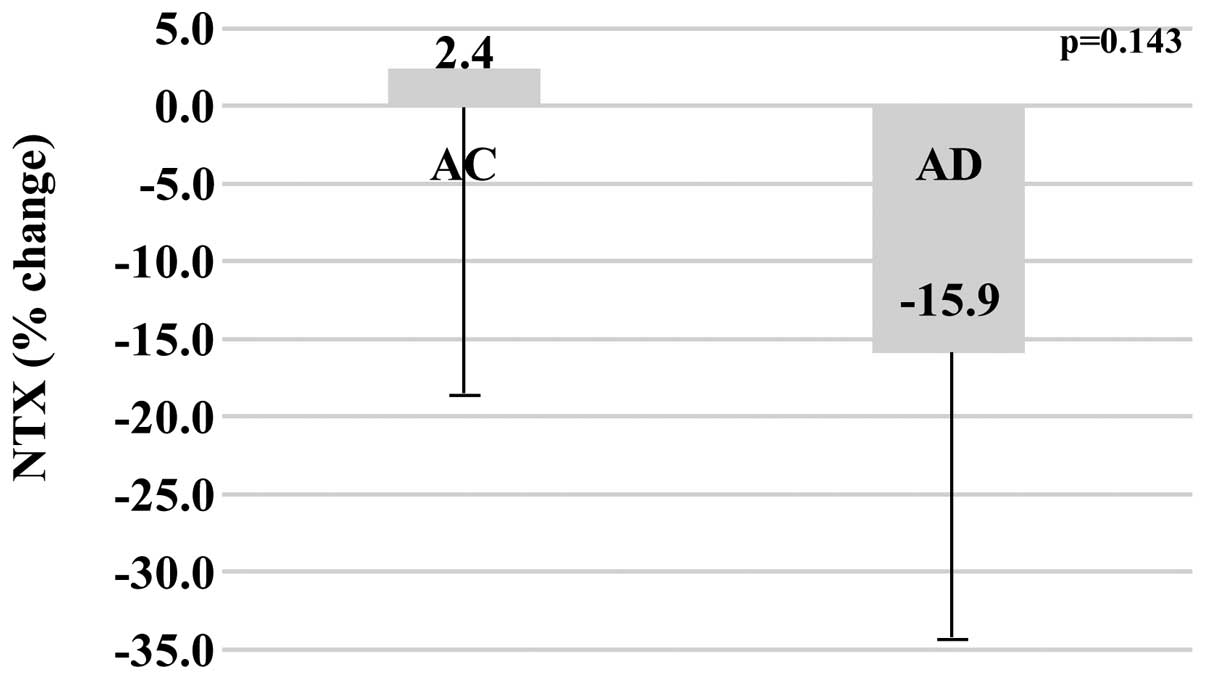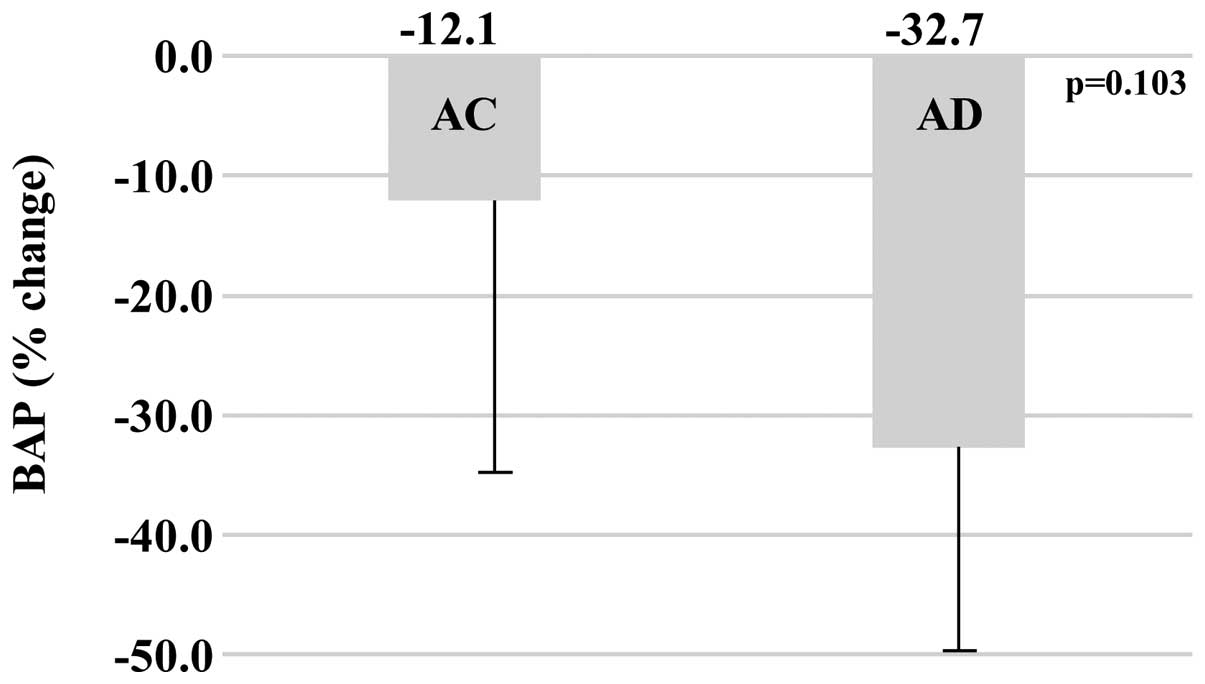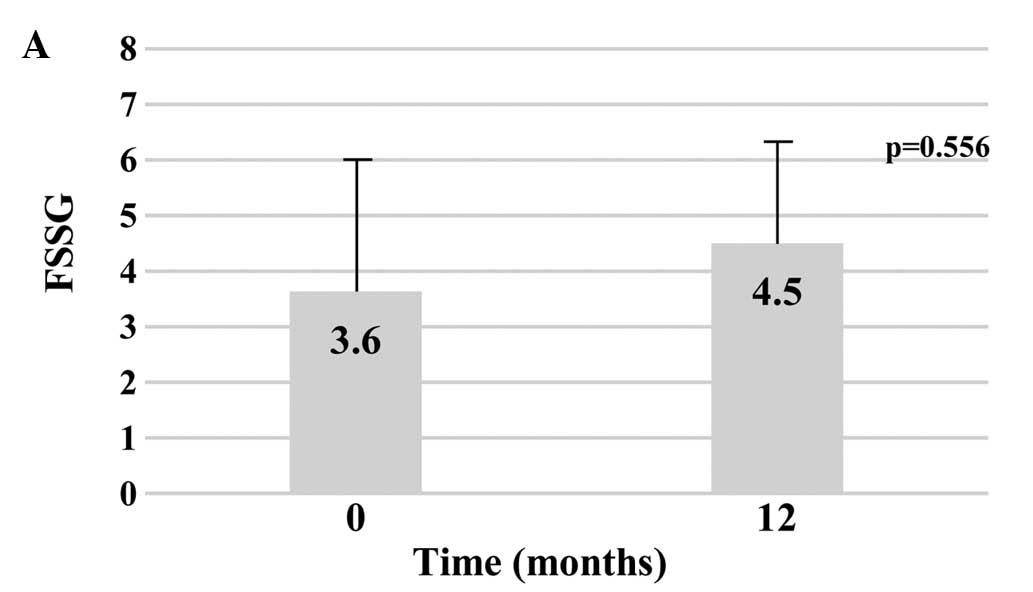Efficacy of alfacalcidol and alendronate on lumbar bone mineral density in osteoporotic patients using proton pump inhibitors
- Authors:
- Published online on: June 30, 2016 https://doi.org/10.3892/br.2016.710
- Pages: 165-170
-
Copyright: © Asaoka et al. This is an open access article distributed under the terms of Creative Commons Attribution License.
Abstract
Introduction
With a rapidly aging population, osteoporosis is a significant concern in Japan. While it is asymptomatic, osteoporosis progresses gradually, leading to hip and lumbar fractures, which may require extended nursing care and threaten life expectancy (1). Therefore, prevention of osteoporosis is important and the efficacy of bisphosphonates in osteoporosis treatment has been supported by previous studies (2). However, side effects of bisphosphonate use are gastrointestinal (GI) disorders (3,4). In the ‘super-aging’ Japanese society, consumption of non-steroidal anti-inflammatory drugs (NSAIDs) and aspirin increases with the greater incidence of joint, ischemic heart and cerebrovascular diseases, with NSAID-induced GI disorders becoming an increasing concern (5,6). In addition, gastric acid secretion in Japanese patients has gradually increased due to a trend towards Westernized eating habits (7) and a decrease in Helicobacter pylori infections, with the number of gastroesophageal reflux disease (GERD) patients also increasing rapidly (8). Proton pump inhibitors (PPIs) are key first-line therapeutic strategies for the treatment of NSAID-induced ulcers and GERD (9). PPIs are often administered as a long-term treatment, and it is common for PPIs to be used concomitantly with bisphosphonates. A previous study suggested that PPI use was associated with a dose-dependent loss of the anti-fracture efficacy of alendronate (AD) (10). However, there are few prospective studies that investigate the efficacy of AD on lumbar bone mineral density (BMD) in osteoporotic patients using concomitant PPIs. The aim of the present study was to investigate the efficacy of AD on lumbar BMD in osteoporotic patients using concomitant PPIs, comparing the effects versus alfacalcidol (AC) in a prospective, randomized, open-label, comparative study.
Materials and methods
Study design
The present study was conducted as a prospective, randomized, open-label, active control, comparative, single-center study. From 2009 until 2013 at Juntendo University Hospital (Tokyo, Japan), osteoporotic patients (age, ≥50 years) who were using PPIs were enrolled in the study. After assignment to the AC (1 µg/day) or AD (35 mg/week) groups, the patients were followed up for one year of treatment. The AD group patients took the medication in the early morning (after an overnight fast) with a glass of plain water, and were instructed to remain upright for ≥30 min before consuming the first food of the day. Patients from the two groups were prohibited from taking any other medication affecting bone or calcium metabolism during the treatment period. Patient profiles [age, gender, body mass index (BMI), alcohol consumption, smoking, comorbidities (type 2 diabetes mellitus and hypertension)] and ongoing concomitant medications [calcium channel blockers (CCBs), low-dose aspirin (LDAA), and 3-hydroxy-3-methylglutaryl-coenzyme A (HMG-CoA) reductase inhibitors] were evaluated. BMI was calculated as body weight divided by the square of body height in meters (kg/m2). Patients that had used standard doses of CCBs, LDAA, or HMG-CoA reductase inhibitors for >6 months were identified as users of that specific therapy. We defined the cases that used the usual dose of PPIs (10 mg rabeprazole or 20 mg omeprazole or 30 mg lansoprazole) for >6 months as users of that specific therapeutic strategy. The study was conducted in accordance with the Declaration of Helsinki. The Juntendo University Ethics Committee approved this study protocol (reference no. 207-028) and patients signed an Ethics Committee-approved informed consent document.
Exclusion criteria
Patients with osteoporosis were selected for the present study, however, certain individuals were excluded according to the following criteria: Patients who were currently or previously being treated with glucocorticoids, hormone replacement therapy, thyroid/parathyroid medication, psychotropic medication, anticonvulsants, selective estrogen receptor modulators or calcium were excluded. Patients with the following conditions were also excluded: Gastrectomy, inflammatory bowel disease, malignant disease (gastric, esophageal, colon, lung, pancreatic, liver, bile duct, gallbladder, breast, uterine, ovarian, prostate, and bladder cancer, malignant lymphoma, leukemia and multiple myeloma), chronic kidney disease, type 1 diabetes mellitus, hypo/hyper-thyroidism, hypo/hyper-parathyroid disorder, rheumatoid arthritis (including other collagen diseases), and those female patients who were premenopausal.
Measurement of lumbar BMD
BMD at lumbar vertebrae 2 through 4 (L2-4) was measured by dual-energy X-ray absorptiometry using a Discovery DXA® system (Hologic; Bedford, MA, USA) and the presence of fragility fractures were investigated in the chest and lumbar spine using lateral vertebral X-rays. The diagnosis of osteoporosis was performed in accordance with the 2000 version of the Japanese Diagnostic Criteria of the Japanese Society for Bone and Mineral Research (11). Degenerative lesions of the vertebrae were ruled out on diagnosing osteoporosis. An osteoporotic patient was defined as one having lumbar BMD values <70% of the young adult mean (YAM) in those without any prevalent fragility fracture. Osteoporosis was also defined as the presence of fragility fractures of any bone in a person with a BMD of <80% of the YAM. Percentage change of lumbar BMD was evaluated from baseline to the end of one year of treatment in the AC and AD groups.
Measurement of bone turnover markers
Serum bone-specific alkaline-phosphatase (BAP; a biomarker of bone formation) and serum collagen type I cross-linked N-telopeptide (NTX; a biomarker of bone resorption) were examined. Percentage changes of NTX and BAP from baseline to the end of one year of treatment were investigated in the AC and AD groups.
Upper GI findings and frequency scale for the symptoms of GERD (FSSG)
The prevalence rate of upper GI endoscopy findings were analyzed, including reflux esophagitis (RE), hiatal hernia (HH) and peptic ulcer disease (PUD). RE was defined as grade A, B, C, or D according to the Los Angeles Classification (12), and PUD as a gastric and/or duodenal ulcer or ulcer scar. HH was defined as an apparent separation of the esophagogastric junction and diaphragm impression by >2 cm at endoscopy. The FSSG score was established via questionnaire (13). Changes in the FSSG score from the baseline to the end of one year of treatment, and findings of upper GI endoscopy (RE, HH and PUD) at baseline and the end of one year of treatment were evaluated.
Endpoint
In addition, the safety of use of the two therapeutic agents over time was evaluated by assessing the side effects experienced by patients in each group.
Statistical analysis
The baseline characteristics were compared between the AC and AD groups by paired t-test or Fisher's exact test. The percentage change from baseline to the end of one year of treatment for lumbar BMD, NTX, and BAP was investigated by paired t-test. The change of FSSG score from baseline to the end of one year of treatment in each group was also investigated by paired t-test and P<0.05 was considered to indicate a statistically significant difference.
Results
Baseline characteristics
Of the 22 patients enrolled in the present study, six were excluded from evaluation [three patients in the AC group (one was excluded due to medication side effects, one due to other disease, and one dropped out of the study) and three patients in the AD group (one due to medication side effects and two dropped out of the study)].
The baseline characteristics are summarized in Table I. Of the 16 eligible patients, eight received AC treatment and eight received AD treatment. In the AC and AD groups, respectively, 1 case vs. 3 cases received rabeprazole; 5 cases vs. 1 case received omeprazole; and 2 cases vs. 4 cases received lansoprazole. As shown in Table 1, there were no significant differences in baseline characteristics between the two treatment groups. There were no patients with fractures at the beginning of the study.
Lumbar BMD
Baseline values of lumbar BMD were 0.62±0.14 g/cm2 for the AC group and 0.70±010 g/cm2 for the AD group (P=0.182). Following one year of treatment, the lumbar BMD values were 0.61±0.12 g/cm2 for the AC group and 0.75±010 g/cm2 for the AD group. The percentage changes in lumbar BMD from baseline to the end of one year of therapy were −0.4±4.0% for the AC group and 6.8±6.3% for the AD group, with significantly effective lumbar BMD findings identified in the AD group (P=0.015; Fig. 1).
Bone turnover markers
The baseline values of bone turnover markers in the AC and AD groups, respectively were as follows: BAP (U/l), 27.4±8.4 vs. 23.5±7.1 (P=0.338); NTX (nmol BCE/l), 12.4±1.9 vs. 15.6±8.3 (P=0.302). After one year of treatment, the values of bone turnover markers in the AC and AD groups, respectively were as follows: BAP (U/l), 23.6±7.3 vs. 15.1±4.1; NTX (nmol BCE/l), 12.8±4.5 vs. 12.6±8.7. When comparing the percentage change between baseline and the end of one year of treatment, the AC group demonstrated less of a change over time in BAP (−12.1±25.5%) compared with the AD group (−32.7±21.7%) (P=0.103), and less of a change over time in NTX (+2.4±25.7%) compared with the AD group (−15.9±21.3%) (P=0.143); although the difference was not statistically significant (Figs. 2 and 3).
Upper GI findings
Baseline findings of the upper GI endoscopy (Table I) indicated no RE in either treatment group, HH in 50.0% of the AC group vs. 25.0% of the AD group (P=0.608), PUD in 37.5% of the AC group vs. 12.5% of the AD group (P=0.569). No novel findings of RE or PUD were observed from baseline to the end of one year of treatment in either group.
FSSG score
The mean baseline values for FSSG were 3.6±3.0 for the AC group vs. 9.4±7.2 for the AD group (P=0.056). After one year of treatment, the mean FSSG values were 4.5±2.8 for the AC group and 8.3±5.1 for the AD group. The change from baseline FSSG scores to the end of one year of treatment was not significantly different in either group (AC group, P=0.556; AD group, P=0.723), respectively (Fig. 4).
Safety analysis
Of the 22 patients that participated in this study, six patients were excluded as mentioned above. In each group, the side effect was mild nausea and the frequency of side effects was the same between the two study groups (one case in each group). New bone fractures were not observed from baseline to the end of one year of treatment in either group.
Discussion
To the best of our knowledge, this is the first prospective, randomized, open-label study to investigate the therapeutic efficacy of AC and AD, as estimated by lumbar BMD changes in osteoporotic patients using concomitant PPIs. Although a recent prospective study comparing AD and AC indicated that AD was more efficacious than AC in increasing lumber BMD (14), the current study of osteoporotic patients using PPIs demonstrated that lumbar BMD change following a one-year treatment with AD was greater than that observed with AC treatment. Furthermore, a previous report indicated that PPI use was associated with a dose-dependent loss of AD anti-fracture efficacy (10). According to certain Japanese prospective studies, the lumbar BMD increase at one year after AD treatment was ~6% (14,15) and in the current study, the lumbar BMD increase after one year of AD treatment in osteoporotic patients using PPIs (6.8%) was similar to a previous study. However, a limitation of the present study was that the number of study subjects was small; thus, further large prospective studies are required to determine the effect of AD in osteoporotic patients using concomitant PPIs.
It is hypothesized that PPIs attenuate the therapeutic effect of bisphosphonate as follows: PPIs may decrease the absorption of calcium; the dissolution of calcium carbonate is a pH-dependent process and gastric pH is particularly important for calcium absorption (16). As PPIs strongly suppress gastric acid secretion, the dissolution of calcium carbonate is inhibited by gastric juice with a high pH and, as a result, calcium absorption may decrease. Similarly, an association between PPI use and bone fracture is suggested in western countries (17); however, certain studies did not report any association between PPI use and bone fracture (18) and there are few prospective studies regarding the association between PPI use and bone fracture.
It was reported that the occurrence of GI adverse events was an independent determinant of persistence with bisphosphonate therapy (19) and adherence to bisphosphonate treatment may decrease due to GI adverse events. However adherence to the bisphosphonate treatment schedule was good in the present study (data not shown).
It was reported that PPIs suppress bone resorption adversely by inhibiting the vacuolar proton pump of the osteoclast (20). However, it was reported that the concentrations of PPIs required for the inhibition of the osteoclast proton pump are markedly higher than the tolerable physiological concentrations (21). Gertz et al (22) reported that increasing gastric pH by infusion of ranitidine was associated with a doubling of AD bioavailability. Recently, Itoh et al (23) reported that risedronate administration in combination with a PPI may be more effective for treating osteoporosis and for improving physical fitness than treatment with risedronate alone, although they evaluated the BMD of the trabecular bone using quantitative computer tomography (23).
According to previous reports, the lumbar BMD increase following one year of AC treatment was ~1% (24,25), while the current study indicated a lumbar BMD change of −0.4% after one year of AC treatment. It was previously reported that bisphosphonates reduce ~50% of bone turnover markers (15); however, no significant difference in bone turnover markers was identified in the present study. A limitation of the current investigation was that the number of study subjects was small; therefore, the effect of AD on bone turnover markers may not have been apparent.
It was suggested that osteoporotic patients exhibiting lumbar pressure fractures or kyphosis are at risk of GERD (26,27). Miyakoshi et al (28) also reported that increases in the angle of lumbar kyphosis and the number of lumbar vertebral fractures may represent very important risk factors for GERD in osteoporotic patients. However, there are few reports about the association between GERD symptoms using FSSG and bisphosphonates. In the current study, the FSSG score did not change after the one-year treatment with AD; therefore, the increase in GERD symptoms triggered by long-term use was not observed.
Since there were no significant changes in frequency or severity of side effects in the two treatment groups in this study, concomitant PPI use with AD may present as a safe therapeutic strategy. Furthermore, no increased findings of RE or PUD were observed over the one year of treatment with either AD or AC. As the residence time in the esophagus of the medication was considered a mechanism of the risk for esophagitis (4), the patients in the current study were instructed comprehensively about the appropriate dosing regimen (taking a tablet with enough water and remaining upright for ≥30 min before the first food of the day).
There were certain limitations of the current study. The study was not a double-blind trial, but an open-labeled study. The number of study subjects was particularly small; therefore, a large prospective multicenter trial is required. Furthermore, patients used different PPIs, which may have influenced certain results, such as lumbar BMD and the FSSG score. Family histories of osteoporosis or certain other important risk factors, such as exercise, sunlight exposure, dietary calcium intake, or the use of over-the-counter medication and other nutrients were not investigated.
In conclusion, the present study demonstrated via lumbar BMD change that a one-year treatment with AD was more efficacious than with AC in osteoporotic patients using PPIs. Furthermore, as with previous reports, the percentage change in lumbar BMD following one year of AD treatment was similar (6.8%) in osteoporotic patients using PPIs. However, additional, large prospective multicenter trials are required to further clarify the efficacy of bisphosphonate administration with PPIs in osteoporosis treatment.
References
|
Iki M: Epidemiology of osteoporosis in Japan. Clin Calcium. 22:797–803. 2012.(In Japanese). PubMed/NCBI | |
|
Liberman UA, Weiss SR, Bröll J, Minne HW, Quan H, Bell NH, Rodriguez-Portales J, Downs RW Jr, Dequeker J, Favus M, et al: The Alendronate Phase III Osteoporosis Treatment Study Group: Effect of oral alendronate on bone mineral density and the incidence of fractures in postmenopausal osteoporosis. N Engl J Med. 333:1437–1443. 1995. View Article : Google Scholar : PubMed/NCBI | |
|
de Groen PC, Lubbe DF, Hirsch LJ, Daifotis A, Stephenson W, Freedholm D, Pryor-Tillotson S, Seleznick MJ, Pinkas H and Wang KK: Esophagitis associated with the use of alendronate. N Engl J Med. 335:1016–1021. 1996. View Article : Google Scholar : PubMed/NCBI | |
|
Graham DY, Malaty HM and Goodgame R: Primary amino-bisphosphonates: A new class of gastrotoxic drugs - comparison of alendronate and aspirin. Am J Gastroenterol. 92:1322–1325. 1997.PubMed/NCBI | |
|
Yoshimura N, Muraki S, Oka H, Kawaguchi H, Nakamura K and Akune T: Cohort profile: Research on osteoarthritis/osteoporosis against disability study. Int J Epidemiol. 39:988–995. 2010. View Article : Google Scholar : PubMed/NCBI | |
|
Nagasue T, Nakamura S, Kochi S, Kurahara K, Yaita H, Kawasaki K and Fuchigami T: Time trends of the impact of Helicobacter pylori infection and nonsteroidal anti-inflammatory drugs on peptic ulcer bleeding in Japanese patients. Digestion. 91:37–41. 2015. View Article : Google Scholar : PubMed/NCBI | |
|
Kinoshita Y, Kawanami C, Kishi K, Nakata H, Seino Y and Chiba T: Helicobacter pylori independent chronological change in gastric acid secretion in the Japanese. Gut. 41:452–458. 1997. View Article : Google Scholar : PubMed/NCBI | |
|
Fujiwara Y and Arakawa T: Epidemiology and clinical characteristics of GERD in the Japanese population. J Gastroenterol. 44:518–534. 2009. View Article : Google Scholar : PubMed/NCBI | |
|
Malfertheiner P, Fass R, Quigley EM, Modlin IM, Malagelada JR, Moss SF, Holtmann G, Goh KL, Katelaris P, Stanghellini V, et al: Review article: From gastrin to gastro-oesophageal reflux disease - a century of acid suppression. Aliment Pharmacol Ther. 23:683–690. 2006. View Article : Google Scholar : PubMed/NCBI | |
|
Abrahamsen B, Eiken P and Eastell R: Proton pump inhibitor use and the antifracture efficacy of alendronate. Arch Intern Med. 171:998–1004. 2011. View Article : Google Scholar : PubMed/NCBI | |
|
Orimo H, Hayashi Y, Fukunaga M, Sone T, Fujiwara S, Shiraki M, Kushida K, Miyamoto S, Soen S, Nishimura J, et al: Osteoporosis Diagnostic Criteria Review Committee: Japanese Society for Bone and Mineral Research: Diagnostic criteria for primary osteoporosis: Year 2000 revision. J Bone Miner Metab. 19:331–337. 2001. View Article : Google Scholar : PubMed/NCBI | |
|
Lundell LR, Dent J, Bennett JR, Blum AL, Armstrong D, Galmiche JP, Johnson F, Hongo M, Richter JE, Spechler SJ, et al: Endoscopic assessment of oesophagitis: Clinical and functional correlates and further validation of the Los Angeles classification. Gut. 45:172–180. 1999. View Article : Google Scholar : PubMed/NCBI | |
|
Kusano M, Shimoyama Y, Sugimoto S, Kawamura O, Maeda M, Minashi K, Kuribayashi S, Higuchi T, Zai H, Ino K, et al: Development and evaluation of FSSG: Frequency scale for the symptoms of GERD. J Gastroenterol. 39:888–891. 2004. View Article : Google Scholar : PubMed/NCBI | |
|
Shiraki M, Kushida K, Fukunaga M, Kishimoto H, Taga M, Nakamura T, Kaneda K, Minaguchi H, Inoue T, Morii H, et al: The Alendronate Phase III Osteoporosis Treatment Research Group: A double-masked multicenter comparative study between alendronate and alfacalcidol in Japanese patients with osteoporosis. Osteoporos Int. 10:183–192. 1999. View Article : Google Scholar : PubMed/NCBI | |
|
Uchida S, Taniguchi T, Shimizu T, Kakikawa T, Okuyama K, Okaniwa M, Arizono H, Nagata K, Santora AC, Shiraki M, et al: Therapeutic effects of alendronate 35 mg once weekly and 5 mg once daily in Japanese patients with osteoporosis: A double-blind, randomized study. J Bone Miner Metab. 23:382–388. 2005. View Article : Google Scholar : PubMed/NCBI | |
|
Sipponen P and Härkönen M: Hypochlorhydric stomach: A risk condition for calcium malabsorption and osteoporosis? Scand J Gastroenterol. 45:133–138. 2010. View Article : Google Scholar : PubMed/NCBI | |
|
Yang YX, Lewis JD, Epstein S and Metz DC: Long-term proton pump inhibitor therapy and risk of hip fracture. JAMA. 296:2947–2953. 2006. View Article : Google Scholar : PubMed/NCBI | |
|
Kaye JA and Jick H: Proton pump inhibitor use and risk of hip fractures in patients without major risk factors. Pharmacotherapy. 28:951–959. 2008. View Article : Google Scholar : PubMed/NCBI | |
|
Penning-van Beest FJ, Goettsch WG, Erkens JA and Herings RM: Determinants of persistence with bisphosphonates: A study in women with postmenopausal osteoporosis. Clin Ther. 28:236–242. 2006. View Article : Google Scholar : PubMed/NCBI | |
|
Tuukkanen J and Väänänen HK: Omeprazole, a specific inhibitor of H+-K+-ATPase, inhibits bone resorption in vitro. Calcif Tissue Int. 38:123–125. 1986. View Article : Google Scholar : PubMed/NCBI | |
|
Mattsson JP, Väänänen K, Wallmark B and Lorentzon P: Omeprazole and bafilomycin, two proton pump inhibitors: Differentiation of their effects on gastric, kidney and bone H(+)-translocating ATPases. Biochim Biophys Acta. 1065:261–268. 1991. View Article : Google Scholar : PubMed/NCBI | |
|
Gertz BJ, Holland SD, Kline WF, Matuszewski BK, Freeman A, Quan H, Lasseter KC, Mucklow JC and Porras AG: Studies of the oral bioavailability of alendronate. Clin Pharmacol Ther. 58:288–298. 1995. View Article : Google Scholar : PubMed/NCBI | |
|
Itoh S, Sekino Y, Shinomiya K and Takeda S: The effects of risedronate administered in combination with a proton pump inhibitor for the treatment of osteoporosis. J Bone Miner Metab. 31:206–211. 2013. View Article : Google Scholar : PubMed/NCBI | |
|
Orimo H, Shiraki M, Hayashi Y, Hoshino T, Onaya T, Miyazaki S, Kurosawa H, Nakamura T and Ogawa N: Effects of 1 alpha-hydroxyvitamin D3 on lumbar bone mineral density and vertebral fractures in patients with postmenopausal osteoporosis. Calcif Tissue Int. 54:370–376. 1994. View Article : Google Scholar : PubMed/NCBI | |
|
Shikari M, Kushida K, Yamazaki K, Nagai T, Inoue T and Orimo H: Effects of 2 years' treatment of osteoporosis with 1 alpha-hydroxy vitamin D3 on bone mineral density and incidence of fracture: A placebo-controlled, double-blind prospective study. Endocr J. 43:211–220. 1996. View Article : Google Scholar : PubMed/NCBI | |
|
Yoshimura M, Nagahara A, Ohtaka K, Shimada Y, Asaoka D, Kurosawa A, Osada T, Kawabe M, Hojo M, Yoshizawa T, et al: Presence of vertebral fractures is highly associated with hiatal hernia and reflux esophagitis in Japanese elderly people. Intern Med. 47:1451–1455. 2008. View Article : Google Scholar : PubMed/NCBI | |
|
Yamaguchi T, Sugimoto T, Yamada H, Kanzawa M, Yano S, Yamauchi M and Chihara K: The presence and severity of vertebral fractures is associated with the presence of esophageal hiatal hernia in postmenopausal women. Osteoporos Int. 13:331–336. 2002. View Article : Google Scholar : PubMed/NCBI | |
|
Miyakoshi N, Kasukawa Y, Sasaki H, Kamo K and Shimada Y: Impact of spinal kyphosis on gastroesophageal reflux disease symptoms in patients with osteoporosis. Osteoporos Int. 20:1193–1198. 2009. View Article : Google Scholar : PubMed/NCBI |













